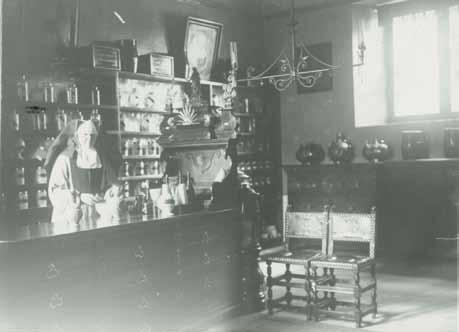
4 minute read
Pharmacists in Bruges in the sixteenth and seventeenth centuries
Ev elien Vanden Ber ghe
Advertisement
They shook, they stared as white’s their shirt: Them it was their poison hurt. -I tell the tale that I heard told. Mithridates, he died old. A. E. Housman (1859–1936). A Shropshire Lad. 1896
The pharmacist’s profession grew out of that of the grocer-druggist. Practitioners belonged to the ‘Neeringhe van de Cruydhalle’, had premises in the municipal market hall and were meesseniers or traders. They sold spices, confectionery and dried fruit. Over time, some of them began to produce their own preparations in addition to selling them, marking the first steps into the profession of pharmacist. That profession gradually became more official: a series of municipal by-laws were introduced to regulate and standardise the sector. The first ordinance concerning pharmacists dates from the late fifteenth century (1497) and focused on the control of their preparations. It was above all in the sixteenth and seventeenth centuries, however, that a whole series of new regulations were imposed. A later by-law of 1582 specifies that pharmacists had first to complete a threeyear apprenticeship and undergo a test of their knowledge. This approach not only enhanced the quality of pharmacists’ training, it also gave customers a degree of confidence in their abilities.
The key development was in 1697, when the first Bruges pharmacopoeia appeared. The publication of this official list of medicines, their effects and instructions for use, did not proceed smoothly. Pharmacists objected especially to the stringent regulation not only of the preparations themselves, but also the price they were permitted to charge for them. To make matters worse, rather than a pharmacist it was – horror of horrors – the physician Dr Vanden Zande who drew up the pharmacopoeia. An ordinance dating from 1760 refers to a new, second, pharmacopoeia, but no trace of this has so far been found. The key innovation did not occur until the eighteenth century, when the Collegium Medicum was founded to regulate the medical professions and on which there were two permanent seats for pharmacists. Meanwhile, there had been a pharmacy in the
26 Sister Aloïse Hammers in the pharmacy (nineteenth century). Album Zusters van Sint-Jan
27 Medicine jar labelled ‘Theriaca’, seventeenth century
former brothers’ quarters at Sint-Janshospitaal since 1645 (Fig. 26), by which time only nuns were employed as nurses. They were assisted in the pharmacy by qualified pharmacists until around 1651. The pharmacists were responsible for purchasing the necessary supplies, but they also trained the nuns so that they could run the pharmacy independently. The sisters subsequently trained each other themselves. They appear to have been left to their own devices as pharmacists’ freedom was being curtailed in the sixteenth and especially the seventeenth century, and while the sector was being professionalized.
The nuns refer to themselves in the surviving accounts as zusters-apothecaresses, although no evidence has been found that they ever completed an apprenticeship or passed an examination. This might have been because they only prepared medicines for their own patients and for nearby Bruges hospitals like Sint-Juliaan. The nuns are known to have exchanged formulas with other convents. The Winckelbouck (‘Shop Book’) – although it only dates from the eighteenth century – records that a nun received a formula from a certain Sister Robertine of St Catherine, the religieuse ziekenmeesteres from the Penitents Convent in Oudenaarde.
They did not, however, escape oversight entirely. The pharmacy at Sint-Janshospitaal also prepared the remedy theriac or mithridate (Fig. 27), a celebrated ancient panacea, originally intended as an antidote to poison, developed for King Mithridates vi (second century bce). The Romans discovered it via Nero’s personal

27 26
physician Andromachus, and it enjoyed considerable popularity until the eighteenth century. There were several variations and the most elaborate formula included over 60 ingredients, the quality of which was so important that they had to be approved in advance before preparation could even begin. Various formulas have survived, including several from the sixteenth and seventeenth centuries, indicating that the hospital pharmacy produced exceptionally large quantities of theriac.
In addition to separate formula sheets, theriac recipes are found in numerous pharmaceutical publications, one of which was set down in the Winckelbouck, begun in 1751, by an apothecaresse. A version of this miracle drug also appears in another, largely unknown work in the hospital pharmacy by the ‘forgotten’ Bruges pharmacist Joannes or Jan Bisschop: Pharmacia Galenica & chymica. De vermeerderde ende verbeterde Apotheker en Alchymiste Licht ende Distilleerkonst (Fig 28). The author of this intriguing little book long remained unidentified until his initials i.b.s.i. gave him away: Jan Bisschop Societatis Jesu. We know from a variety of sources that Jan Bis
schop was born in Bruges in 1590 and probably worked there for a time as a pharmacist. It is also assumed that he was trained in the city. He even refers in surviving documents to ha- ving visited ‘het gasthuis’, which most probably refers to Sint-Janshospitaal. Bisschop moved to Ghent in 1613, where he joined the Jesuit or- der. He ran the apothecarije there and trained numerous apprentice pharmacists who went on to pass the official examination. He later served as official pharmacist at the Vienna court of Em- peror Ferdinand ii. His book probably owed its sales to its extremely practical approach: Bis- schop himself explicitly states that he wrote it ‘to educate pharmacists’. An appealing piece of evidence that he succeeded in his goal is found on the final page of the copy in Sint-Janshospi- taal (1667 edition), which is inscribed ‘Book for the use of Sister Eleanora Verbeke, now a nun at the hospital of St John in Bruges, 1741’.
28 Jan Bisschop, Pharmacia Galenica & Chymica. De vermeerderde ende verbeterde Apotheker en Alchymiste Licht ende Distilleerkonst, 1667, OCMW collection.
28











